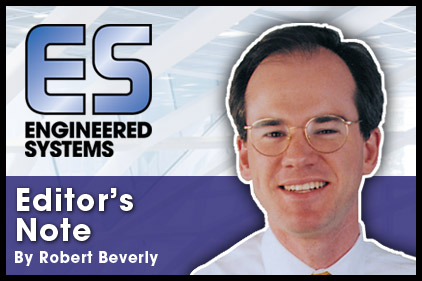“What’s that?”
“Those are the defaults.”
“From the last month?”
“No, from today.”
“What do you do with it?”
“I take it off and throw it away.”
“Why?”
“Because I can’t do anything with it. It doesn’t tell me what to do or give me actionable data. Unless I get a hot call or a cold call, I don’t do anything. Everybody’s comfortable? I don’t do anything.”
That’s an anecdote passed along from our High-Performance Buildings (HPB) keynote speaker, Craig Walker of United Technologies Research Center. How to avoid that situation, which might be described as “declaring data bankruptcy” in this era of info overload, was just one impasse out of many logjams and challenges that our HPB presenters tackled in Falls Church, VA.
I knew we were getting off to a good start on Tuesday (the bonus half-day we added) when the first speaker in my own track was excellent: Liam Buckley of IES Consulting, presenting on “Integrating Tools, Technologies & Strategies for Designing High-Performance Buildings.” Attendees got a good feel for how IES is working to build that performance into the design through disciplined, informed attention in the right places.
He also shared a good tidbit about the Army: They design to LEED® and then don’t submit, because they don’t care about a plaque.
ATTACKING ‘DELTA PLAQUE’
Of course, part of the problem at this moment in the buildings industry is the frequent gap between the accomplishment signified by popular building certifications and the post-occupancy status quo of system performance. Part of that is “inefficiency creep” as time goes on. Regarding this, Walker also said that until you come back and recommission, “you’re working at a 20% to 40% hindrance, and that’s not good value.” Especially if the owner did invest a little more up front to earn that plaque.
That leads us to one of the more insightful, practical features we’ve had in my tenure here, written by a team from Go Sustainable Energy, a commissioning and energy audit firm in Columbus, OH. They’ve seen an unsettling number of cracks in the armor of the traditional “energy-efficiency army” over the course of their work. From near-impossible-to-catch modeling errors to operations oversights to the owner (or his team) abdicating too much responsibility in the decisionmaking process, the array of stealthy pitfalls that comprise the “culture of inefficiency” is unsettling. And it’s also something you should definitely read and file.
Anyway, I want to thank all the speakers and attendees who made this year’s conference a success, including our own event staff and everyone at Building Intelligence Group.
Related, I’m curious: Attendees get links to presentation PDFs, but for those who couldn’t attend: would you be interested in access to archived presentations from future conferences, available for a reasonable price? Take our homepage poll at www.esmagazine.com. Thanks, we’ll see you next month. ES
ESWebinars
Here are just a few of the topics in our webinar archives at
http://webinars.esmagazine.com
Chilled Beams
Heat Recovery
VRF
Boiler Rules
Heat Pipe Systems
Firetube Boilers
Enthalpy Wheels
IndustryEvents
OCTOBER 29-30
2012 ASHRAE/NIST Refrigerants
Conference: Moving Toward
Sustainability
Gaithersburg, MD
For info, visit www.ashrae.com.
NOVEMBER 12-14
7th International Cold Climate HVAC Conference
ASHRAE, REHVA, and SCANVAC.
Calgary, Alberta, Canada.
For info, visit www.ashrae.com.
NOVEMBER 14-16
Greenbuild
U.S. Green Building Council
For info, visit www.greenbuildexpo.com.
DECEMBER 3-7
National BIM Conference
AEC Science & Technology
Washington. For info, visit http://www.aececobuild.com/bim-conference.
2013
JANUARY 26-30
2013 ASHRAE Winter Conference
Dallas. For info, www.ashrae.org.Our scene takes place in a facility engineer’s office. In the corner, there’s a dot-matrix printer just spewing out stuff. A pile — a big pile — of printouts has accumulated.







